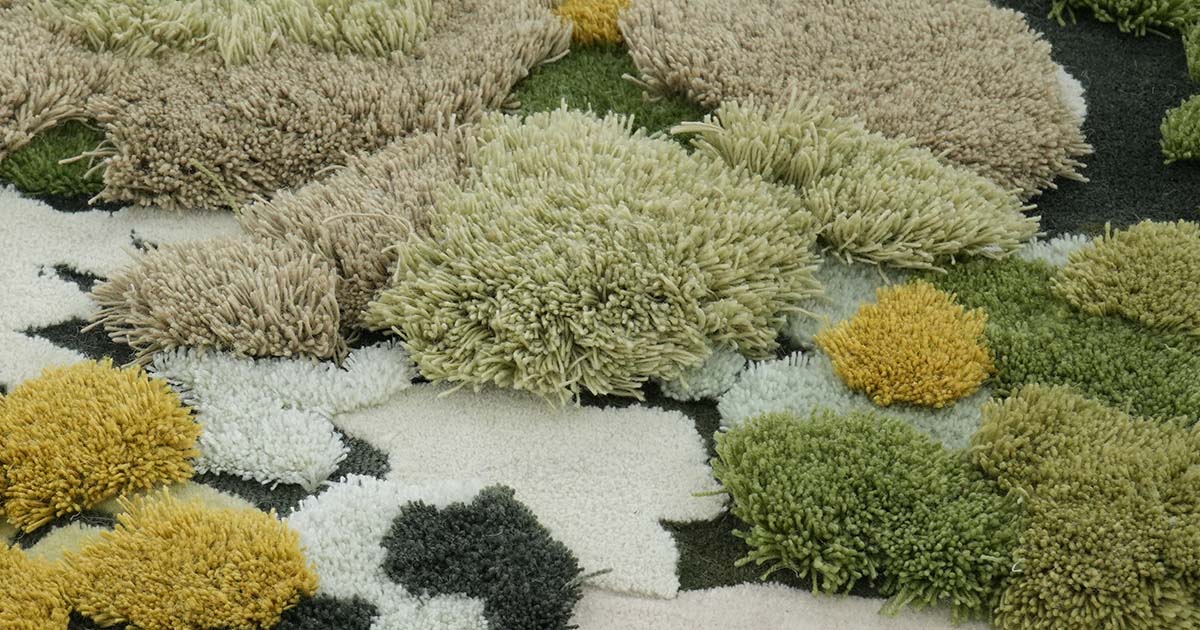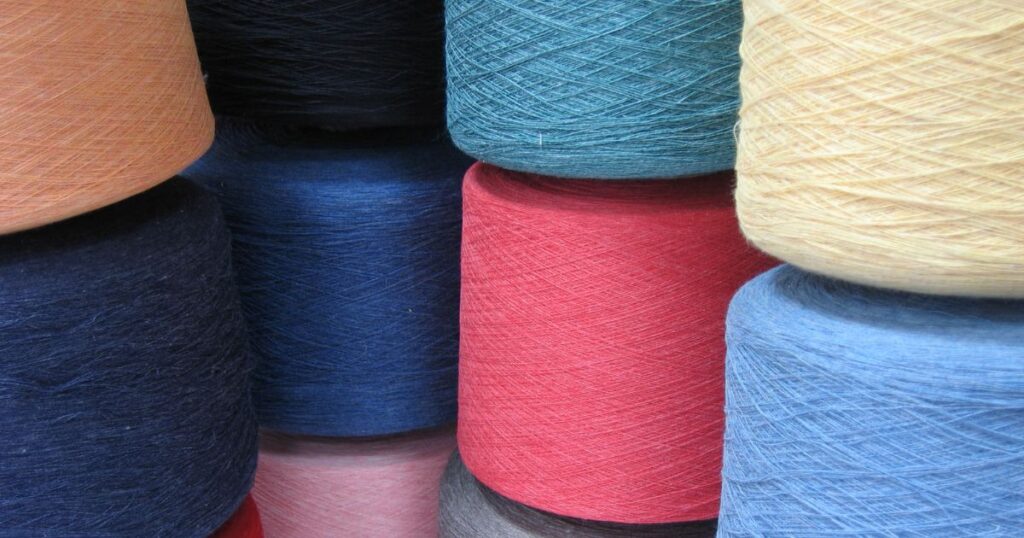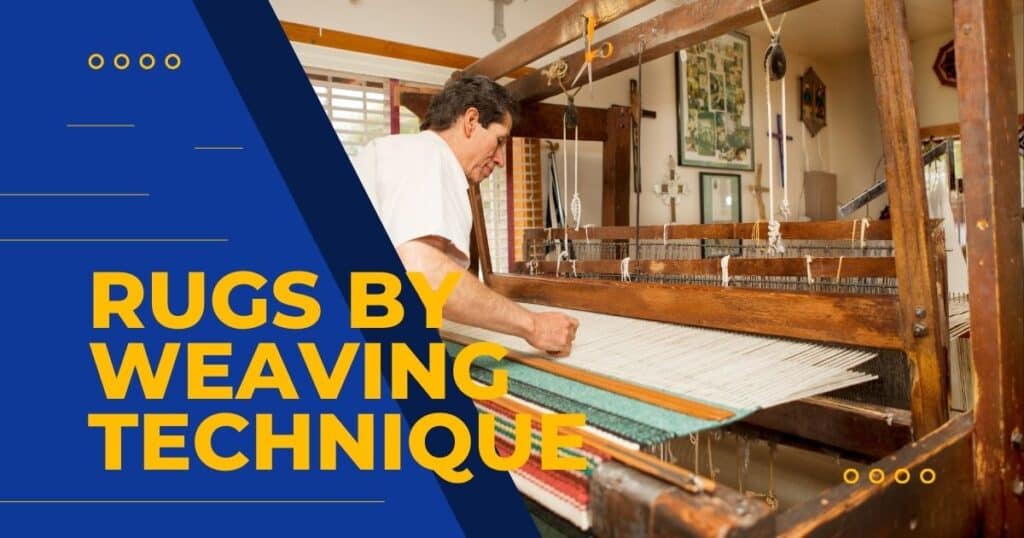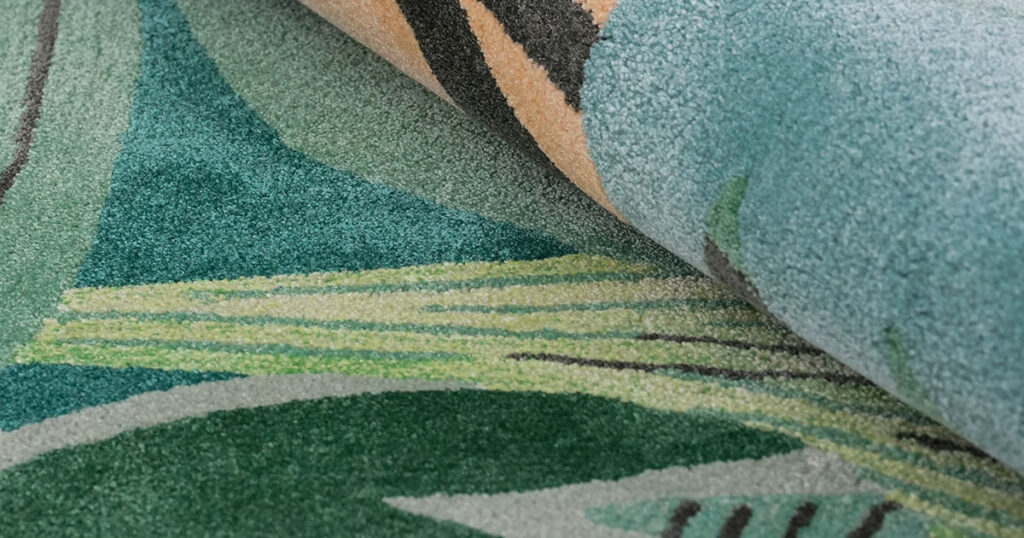This comprehensive guide will walk you through everything you need to know about tufted rug quality.
- From initial design considerations to production techniques and evaluation methods.
You’ll learn to recognize the subtle details that differentiate premium tufted rugs from inferior options.
Ensure your investment stands the test of time.
Understanding the Tufting Process
Before we dive into quality factors, let’s explore exactly how tufted rugs are created:
The Fundamentals of Tufting
A tufted rug begins with a foundation cloth stretched on a frame. The design is typically drawn or printed onto this backing. Then, using either a hand-held tufting gun or specialized machinery, yarn is punched through this foundation cloth, creating loops on the surface.
These loops can either be left intact (loop pile) or cut open (cut pile). After tufting, the back of the rug is coated with latex adhesive to secure the tufts, and a secondary backing fabric is attached to create a finished look and add stability.
Hand-Tufted vs. Machine-Tufted
Hand-Tufted Rugs
They are created by artisans using tufting guns to manually insert yarn through the foundation cloth. This semi-handcrafted method offers:
- Greater artistic freedom for custom designs
- Ability to create varied pile heights and textures within one rug
- Detail work like hand-carving for dimensional effects
- Flexibility for one-off or small-batch custom production
Hand-tufted rugs from quality makers can last 10-20 years in residential settings with proper care, offering a balance of craftsmanship and value.
Machine-Tufted Rugs
Such rugs are produced on industrial tufting machines, often the same ones used to create wall-to-wall carpet.
These offer:
- Precise, uniform tufting with computer-controlled accuracy
- Consistent pile height and density
- Efficiency for large production runs
- Advanced capabilities like computer yarn placement (CYP) for intricate patterns
High-quality machine-tufted rugs can match hand-tufted for durability, lasting 12-20 years if well-maintained.
Neither method is inherently superior – both can produce exceptional rugs when done with quality materials and proper techniques.
- The distinction lies more in customization options and production scale rather than absolute quality.
Design Considerations: Beyond Aesthetics
The quality journey begins at the design stage, where decisions impact not just appearance but durability.
Pattern and Color Selection for Longevity
For high-traffic commercial or residential areas:
- Multi-tonal patterns hide soil and footprints better than solid colors
- Darker colors or medium tones conceal dirt more effectively than light colors
- Textured designs with varied pile heights can disguise wear patterns
- Bold geometrics work better for large rugs as small details may be lost
These design choices aren’t merely aesthetic – they’re functional decisions that extend the rug’s visual lifespan. A solid cream rug might look stunning initially but will show every spill and footprint, while a textured pattern in mixed earth tones might maintain its appearance for years despite heavy use.
Scale and Proportion
The relationship between pattern scale and room size directly impacts perceived quality:
- Large, open spaces can handle bold, sweeping patterns that would overwhelm smaller areas
- Smaller rooms benefit from tighter, more contained designs
- Pattern repeat size should be proportional to the rug dimensions
- Border designs should be balanced against the field size (approximately 10-15% of width for balanced proportions)
A common mistake is selecting a pattern that’s either too large or too small for the space, creating a visual disconnect that makes even a well-made rug appear unsuitable.
Technical Feasibility
Not every design translates well to tufting. Quality manufacturers will guide you on what works best:
- Very fine lines (under 1/4 inch) may be difficult to execute cleanly
- Extremely intricate details might blur in tufted form
- Gradients and shading require skilled execution
- Certain color combinations may create bleeding risks
Working with knowledgeable manufacturers during the design phase helps ensure the final product meets expectations.
They can suggest modifications that retain your design intent while optimizing for the tufting process.
Rug Yarns: The Quality Foundation
The yarn used in a tufted rug dramatically affects performance, appearance, and lifespan. Here’s a detailed breakdown of fiber options:
Wool: The Gold Standard
New Zealand wool is widely considered the premium choice for quality tufted rugs. Its natural characteristics include:
- Exceptional resilience – wool fibers have a natural coiled structure that allows them to spring back after compression, resisting crushing and matting even under heavy furniture
- Natural soil resistance – the lanolin in wool creates a protective barrier that repels stains and allows easier cleaning
- Temperature regulation – wool adapts to ambient conditions, feeling cool in summer and warm in winter
- Inherent flame resistance – wool naturally self-extinguishes, an important safety feature
- Dimensional stability – minimal stretching or shrinking with humidity changes
- Long staple length – quality wool has longer fibers that shed less and resist pilling
- Rich color acceptance – wool takes dye beautifully for vibrant, long-lasting color
A high-quality wool tufted rug can easily last 15-20 years in residential settings with proper care. In commercial environments, expect 5-10 years of attractive service.
What to watch for:
- Initial shedding is normal and will diminish with regular vacuuming.
- Lower-quality wool (recycled or shorter staple) will shed more persistently and may feel coarser.
Acrylic: Visual Appeal at Lower Cost
Acrylic yarn offers certain advantages but with trade-offs:
- Vibrant, fade-resistant colors – excellent light fastness
- Soft, plush feel when new – often used for deep pile rugs
- Good resistance to water-based stains – non-absorbent nature repels many liquids
- Lower price point than wool or nylon
- Recycled options available (often from PET bottles)
The primary limitation of acrylic is its lower resilience.
Under heavy foot traffic, acrylic fibers tend to crush and flatten, developing worn paths more quickly than wool or nylon.
This makes it best suited for:
- Bedrooms and less-used formal areas
- Decorative rugs rather than workhorses
- Budget-conscious projects where replacement after 3-5 years is acceptable
Quality indicator:
- Higher-density acrylic rugs perform better than sparse ones.
- Look for tight, dense construction if choosing acrylic.
Fiber Blends: Strategic Combinations
Quality rug makers often blend fibers strategically to leverage their strengths:
Wool-Acrylic Blends (80/20 or 70/30):
- Combines wool’s luxury look and feel with nylon’s added strength
- Reduces cost slightly compared to 100% wool
- Often used in hospitality settings for balance of appearance and performance
- Typically performs nearly as well as pure wool with slightly better wear in heavy traffic
Wool with Silk, Viscose, or Art Silk Accents:
- Adds lustrous highlights to wool’s matte texture
- Creates dimension in carved designs
- Provides sheen that catches light
- Best used strategically in low-traffic areas as accent elements
- Viscose (rayon) and art silk are less durable than real silk
Quality indicator:
- In blends, the predominant fiber determines performance.
- Be wary of rugs marketed as “wool blend” without percentages specified – they may contain minimal wool.
Matching Materials to Usage Requirements
Different environments demand different materials. Here’s a strategic approach to material selection:
Commercial High-Traffic Areas
Optimal choices: 100% high-grade wool, solution-dyed nylon, or wool-nylon blend (80/20)
Recommended construction: Low to medium loop pile or tight, dense cut pile
Why: These areas need maximum crush resistance, stain protection, and appearance retention
Examples: Hotel lobbies, retail entrances, busy corridors, restaurant dining rooms
Commercial Moderate-Traffic Areas
Optimal choices: Wool, wool-nylon blends, high-quality nylon, commercial-grade polyester
Recommended construction: Medium cut or loop pile, potentially cut-and-loop for visual interest
Why: Balance of appearance and performance with some flexibility for comfort
Examples: Office spaces, boutique retail, conference rooms, hotel guest rooms
Residential High-Traffic Areas
Optimal choices: Wool, nylon, wool-nylon blends
Recommended construction: Medium-height dense cut pile or loop pile
Why: Needs to withstand daily family use while providing comfort
Examples: Family rooms, hallways, stairs, entryways
Residential Low-Traffic Areas
Optimal choices: Any fiber, including plush wool, polyester, or wool with silk/viscose accents
Recommended construction: Higher cut pile for luxury feel, potentially hand-carved details
Why: When wear is minimal, comfort and aesthetics can take precedence
Examples: Formal living rooms, master bedrooms, guest rooms, dining rooms
Pile Types and Construction
The pile (surface) of a tufted rug significantly impacts both appearance and performance:
Cut Pile Variations
Plush/Velvet Cut Pile:
- Yarns stand straight up for a smooth, formal look
- Sheared to an even height
- Creates a rich, luxurious surface
- Shows footprints and vacuum marks (sometimes called “pooling” or “shading”)
- Best for formal settings with moderate traffic
Textured Cut Pile:
- Yarns of different heights create surface variation
- Informal, versatile appearance
- Hides soil and footprints well
- Good all-around performer for various settings
Loop Pile Variations
Level Loop:
- All loops at uniform height
- Creates a clean, ordered appearance
- Extremely durable construction
- Shows fewer traffic patterns
- Ideal for high-use areas
Multi-Level Loop:
- Loops at different heights create pattern and texture
- More interesting visual and tactile effect
- Hides soil exceptionally well
- Very durable while less flat-looking than level loop
- Good for both commercial and residential high-traffic areas
Cut & Loop Combinations
This versatile construction combines cut and loop sections to create:
- Sculptural effects with height variation
- Textural patterns without color changes
- Visual interest through surface contrast
- Defined patterns that resist showing wear
- Details through the interplay of light and shadow
Premium cut-and-loop rugs feature:
- Clean transitions between cut and loop areas
- Precise pattern definition
- Even cut heights and loop formation
- Careful carving along pattern edges
- Strategic use of contrast for clarity
Pile Height Considerations
Pile height significantly impacts both appearance and performance:
Low Pile (6mm/¼” or less):
- Maximum durability for heavy traffic
- Minimum crushing and matting
- Easier cleaning and maintenance
- Less cushioning underfoot
- Allows doors to clear easily
- Commercial environments often specify 4-6mm
Medium Pile (6-12mm/¼” to ½”):
- Balances comfort and performance
- Good durability with adequate resilience
- Suitable for most residential and moderate commercial use
- Provides some cushioning while maintaining structure
- Most versatile option for general use
High Pile (over 12mm/½”):
- Maximum softness and luxury
- Creates dramatic visual depth
- Requires more frequent maintenance
- More prone to crushing in traffic paths
- Best for low-traffic, decorative applications
Technical detail:
- As pile height increases, density should also increase to provide adequate support.
- A tall pile without sufficient density will quickly flatten and look worn.
Density: A Critical Quality Factor
Pile density refers to how closely the yarn tufts are packed together. This often-overlooked factor significantly impacts durability:
Measuring and Evaluating Density
Density can be measured in several ways:
- Tufts per square inch/meter – number of yarn ends (higher is better)
- Face weight – ounces of yarn per square yard (higher is better)
- Pile density rating – calculation combining face weight and pile height
For hand-tufted wool rugs, quality benchmarks include:
- Premium quality: >6,000 tufts per square meter
- Good quality: 4,000-6,000 tufts per square meter
- Economy quality: <4,000 tufts per square meter
For machine-tufted commercial carpet/rugs:
- Premium contract grade: 40+ oz/sq yard face weight
- Medium commercial grade: 26-40 oz/sq yard face weight
- Light commercial grade: 20-26 oz/sq yard face weight
Density Test Methods
As a buyer, you can evaluate density through these practical tests:
Bend Test: Fold the rug back on itself. A dense rug will stand firm and show few gaps between tufts. A sparse rug will fold easily, revealing backing between tufts.
Finger Test: Press your fingers firmly into the pile. In a high-density rug, you’ll meet firm resistance and won’t easily touch the backing.
Weight Test: Compare rugs of similar size and construction. The heavier rug typically contains more yarn and has higher density.
Visual Inspection: Look at the rug back or edges where the pile is visible in cross-section. Dense rugs show a thick, packed arrangement of yarn.
Why Density Matters
High density contributes to quality in several ways:
- Tufts support each other against crushing
- Dirt stays near the surface instead of sinking to the backing
- Appearance retention improves significantly
- Tuft bind strength increases (tufts less likely to pull out)
- Rug maintains its original texture longer
This is why even a rug made from premium wool will disappoint if the density is insufficient.
Conversely, a well-constructed rug in a less expensive fiber can outperform if the density is high.
Backing and Construction
While less visible, backing quality significantly affects longevity:
Primary Backing (Foundation)
The foundation cloth provides the base for tufting. Quality indicators include:
- Material strength – premium rugs use heavyweight cotton canvas or monk’s cloth that resists tearing during the tufting process
- Dimensional stability – minimal stretching or distortion when tensioned
- Even weave – consistent texture for uniform tuft placement
- Proper tensioning during manufacturing – prevents rippling or buckling
- Sufficient weight – heavier primary backing provides better tuft anchoring
Inferior primary backings tear during tufting, causing irregular tuft placement or weak spots.
Adhesive Layer
After tufting, latex adhesive secures the tufts. Quality adhesives feature:
- Proper flexibility – remains pliable rather than brittle over time
- Low filler content – quality latex uses minimal clay or calcium carbonate fillers
- Even application – consistent coverage without lumps or voids
- Appropriate penetration – enough to secure tufts without soaking through
- Low VOC content – minimal off-gassing and odor
- Moisture resistance – won’t break down easily if slightly damp
Premium rug makers often add a reinforcement layer (scrim) embedded in the latex for additional stability and to prevent delamination.
Warning signs of poor adhesive:
- Strong, persistent chemical odor
- Excessive stiffness or “cardboard” feel
- White powdery substance shedding from the back
- Cracking sounds when the rug is flexed
Secondary Backing
The final backing cloth should be:
- Securely bonded to the latex layer
- Evenly applied without wrinkles or bubbles
- Neatly finished at the edges
- Made from durable material (cotton, synthetic, or natural fiber)
- Free from visible glue seepage or excess
Higher-end rugs often feature canvas or cotton backing, while more budget-friendly options may use synthetic materials.
Edge Finishing Methods
The edges of tufted rugs can be finished in several ways, each with quality indicators:
Bound Edges:
- Binding tape applied evenly without waviness
- Secure stitching with no loose sections
- Neat corners with proper overlap
- Color-coordinated binding material
Serged Edges:
- Tight, even overlock stitching
- Consistent tension throughout
- No gaps or loose threads
- Smooth corners without bunching
Folded/Self-Finished Edges:
- Premium rugs often fold the backing under and secure it
- Clean, straight fold line
- Invisible securing method (no visible glue)
- Tidy corners with mitered finish
The edge finishing is often where quality differences become most apparent – premium rugs feature meticulous attention to these details.
Professional Evaluation Methods
When assessing tufted rug quality, industry professionals look for these specific indicators:
Construction Assessment
Tuft Bind Strength:
- Professionals may test by trying to pull tufts with pliers
- Quality rugs require significant force to remove tufts
- Commercial specifications typically require 8+ pounds of force
Backing Adhesion:
- Tested by attempting to separate primary and secondary backing
- Quality rugs have firmly bonded layers
- No delamination should occur with moderate force
- Edge lifting is an early warning sign of poor adhesion
Dimensional Stability:
- Measured by checking for rippling or buckling when laid flat
- Quality rugs lie completely flat without edge curling
- Corners should be square and true
- No distortion in pattern elements
Material Quality Tests
Fiber Identification:
- Burn test can identify natural vs. synthetic fibers
- Wool produces a charring smell and crushable ash
- Synthetics melt rather than burn cleanly
- Microscopic examination reveals fiber structure
Colorfastness Testing:
- Light exposure test for fade resistance
- Wet cloth rubbing test for dye transfer
- Water spotting test for watermarks
- Heat test for color stability
Resilience Evaluation:
- Weight placed on pile for 24 hours, then removed
- Quality fibers recover to at least 80% of original height
- Pattern of recovery indicates fiber quality
- Important for high-traffic areas
Sampling and Prototyping Process
For custom tufted rugs, the sampling process is critical to ensuring quality:
Strike-Off Samples:
- Typically 30x30cm or 50x50cm sections showing representative portions of the design
- Contains actual materials, colors, and construction methods of the final rug
- Allows evaluation of color accuracy, texture, and design execution
- Enables testing of density and backing quality
What to Assess in a Sample:
- Color accuracy under different lighting conditions
- Design precision and pattern clarity
- Pile height and texture as specified
- Edge finishing methods
- Backing security and quality
- Initial shedding characteristics
- Overall hand feel and density
Professional buyers live with samples for several days and evaluate them under various lighting conditions before approving production.
Maintenance & Long-Term Quality
Even the finest tufted rug requires proper care to maintain its quality:
Understanding Normal Shedding
New wool rugs will shed initially – this is normal and diminishes with time:
- Caused by short fibers remaining after shearing the pile
- More noticeable in hand-tufted than machine-tufted rugs
- Should decrease significantly after 3-6 months of regular vacuuming
- Not an indication of poor quality unless excessive or persistent
- Can be minimized by using a suction-only vacuum initially
Important distinction:
Shedding (loose fibers) is different from fuzzing (fiber ends breaking) and sprouting (entire tufts coming loose). The latter two indicate quality issues.
Professional Cleaning Considerations
Tufted rugs require specific cleaning approaches:
- Low-moisture extraction is preferred over flood cleaning
- Avoid excessive wetting that could deteriorate latex
- Professional cleaning recommended every 12-18 months
- Hot water extraction with immediate forced drying is acceptable
- Use pH-neutral cleaners specifically for the fiber type
For wool rugs, always:
- Use wool-safe cleaning products (pH 5.5-8.0)
- Avoid chlorine bleach or high alkalinity cleaners
- Test cleaners on an inconspicuous area first
- Allow complete drying before replacing furniture
Preventing Common Issues
Proactive maintenance prevents quality deterioration:
- Rotate rugs periodically to distribute wear
- Use quality rug pads to prevent backing stress
- Address spills immediately before they penetrate to backing
- Place protective cups under heavy furniture
- Use entrance mats to reduce soil brought onto area rugs
- Vacuum regularly – weekly for residential, daily for commercial
Warning Signs of Poor Quality
Be alert for these red flags when evaluating tufted rugs:
Material & Construction Issues
- Excessive initial shedding that fills vacuum bags repeatedly
- Visible primary backing when you separate the pile fibers slightly
- Pattern distortion or irregular design elements
- Uneven pile height where it should be consistent
- Tufts that pull out easily with light tugging
- Stiff, boardlike backing that makes crackling sounds when flexed
- Strong chemical odor that persists after airing out
- Backing separation visible at edges or corners
- Color bleeding when slightly dampened
- Pile that flattens easily and doesn’t recover when brushed
Post-Purchase Quality Indicators
After some use, poor quality becomes evident through:
- Traffic lanes developing quickly (within weeks rather than years)
- Color fading with minimal sun exposure
- Edge deterioration where binding separates or edges fray
- Backing deterioration releasing white powder
- Tuft loss in areas of normal use
- Buckling or rippling when not caused by moisture
- Inconsistent wear patterns unrelated to traffic flow
- Rapid appearance change compared to protected areas under furniture
Premium Quality Indicators
Conversely, these signs point to high-quality tufted rugs:
Material Excellence
- Verified premium materials – documented New Zealand wool, branded nylon, etc.
- Color consistency throughout the rug, even in complex patterns
- Appropriate weight for the construction – substantial but not excessive
- Even, dense pile with uniform appearance
- Resilient texture that springs back after compression
- Natural sheen appropriate to the fiber type
- Consistent dye penetration visible at the base of cut tufts
- Even yarn twist throughout the pile
Construction Superiority
- Clean backing application with no excess adhesive
- Precise pattern execution with sharp definition
- Secure edge finishing with attention to corners
- Minimal odor even when new
- Flexibility without cracking when the rug is rolled
- Balanced dimensions with square corners
- Even tuft distribution throughout the rug
- Invisible seams if the rug contains joined sections
Documentation and Transparency
Premium manufacturers provide:
- Detailed specifications of materials and construction
- Fiber content certificates or verification
- Care instructions specific to the rug’s construction
- Warranty coverage against manufacturing defects
- Test results for commercial applications (flame resistance, colorfastness, etc.)
- Production timeline and origin information
- Sample policy for custom orders
Practical Evaluation Checklist
Use this comprehensive checklist when evaluating tufted rugs:
Visual Inspection
- Even pile height throughout
- Precise pattern alignment
- Consistent color saturation
- Square corners and straight edges
- Neat edge finishing
- Clean, secure backing
- No visible defects or repairs
Physical Testing
- Press into pile – should meet resistance
- Bend rug back – shouldn’t show excessive backing
- Tug gently on tufts – should resist pulling out
- Rub with white cloth – no color transfer
- Smell – minimal or no chemical odor
- Check weight – substantial for size
- Fold corner – should feel flexible but not flimsy
Making Informed Purchasing Decisions
When selecting your tufted rug, consider these comprehensive recommendations:
Commercial Applications
High-Traffic Public Spaces:
- Wool-nylon blends or solution-dyed nylon provide optimal performance
- Loop pile construction offers maximum durability
- Pattern and color should mask soiling (medium tones, textured designs)
- Density is critical – look for commercial-grade specifications
- Consider modular options for sections that can be replaced if damaged
- Edge construction should be reinforced for safety
- Backing systems with additional stability features prevent trip hazards
Executive/Premium Commercial Spaces:
- 100% New Zealand wool provides luxury with performance
- Cut-and-loop construction creates sophisticated texture
- Higher pile height (8-10mm) offers comfort while maintaining durability
- Custom designs can incorporate branding elements
- Consider acoustic benefits for sound absorption
- Edge detail should complement architectural elements
Residential Applications
Family Living Areas:
- Wool or high-quality nylon for durability with comfort
- Medium cut pile (8-12mm) balances softness and resilience
- Multi-colored patterns camouflage inevitable spills
- Density should allow for frequent vacuuming without damage
- Consider furniture layout when choosing pile direction
- Pattern scale should complement room dimensions
Formal or Low-Traffic Areas:
- Premium wool with silk accents offers luxury appearance
- Higher cut pile (12-15mm) provides plush comfort
- Detailed patterns and higher contrast designs work well
- Hand-carved details add sophistication
- Consider seasonal rotation to prevent sun fading
- Coordinating border details enhance formal settings
Custom Design Considerations
For custom tufted rugs, address these specific quality factors:
- Work with manufacturers early in the design process
- Request yarn samples before committing to colors
- Consider model renderings to visualize the completed rug
- Always request physical samples (strike-offs) before full production
- Verify color accuracy under your actual lighting conditions
- Allow adequate production time for quality craftsmanship
- Consider maintenance requirements when specifying details
Ready for Quality Tufted Rugs?
Now that you understand what makes a truly high-quality tufted rug, we’d love to help you find the perfect option for your space.
Our expert team can guide you through material selection, design considerations, and customization options to create a rug that meets your exact specifications and quality standards.
Contact us today to discuss your project needs and discover how a carefully crafted tufted rug can transform your space with both beauty and lasting performance.




